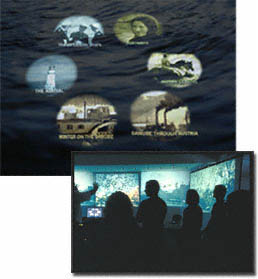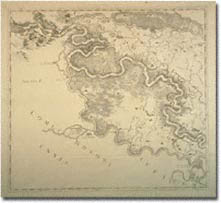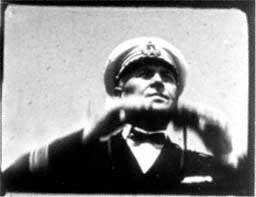|
In this exhibition, Hungarian artist Péter Forgács and the Labyrinth Project at the University of Southern California's Annenberg Center for Communication create an interactive multimedia installation designed to involve visitors in narratives that incorporate found footage of two historic voyages along the Danube River.
The installation includes the amateur film footage of Captain Nándor Andrásovits, who ferried Eastern European Jewish refugees along the Danube River from Slovakia to the Black Sea (and eventually Palestine) in 1939. This narrative is paralleled by a "reverse" exodus that took place one year later, when Andrásovits' ship ferried Bessarabian Germans, who fled to the Third Reich because of the Soviet annexation of Bessarabia.
|

 |
 |
A touchscreen interface (pictured above) allows visitors to navigate through the orchestration of found footage projected on multiple screens (pictured below).
|
 |
 |
Visitors to the installation use a touchscreen interface to navigate through the intersecting tales of the Jews escaping Slovakia, of Bessarabian Germans fleeing Soviet annexation of Bessarabia, of the captain, and of the Danube River. Through its use of the touchscreen technology and design innovations by the artists, the installation allows visitors to experience history as a stream of moments and memories that can always be understood in new ways.
This experience is enhanced by an audio mix that includes ambient sounds of the river and harbor, the mechanical rhythms of ships' engines, regional music from the period, songs and prayers of the refugees, voice-overs of the captain and his passengers, and the haunting minimalist music of composer Tibor Szemzö, who has collaborated with Forgács on all of his previous films. The exhibition also includes early eighteenth-century maps of the Danube River and drawings of the region from the special collections of the Research Library at the Getty Research Institute.
|
 |

 |
 |
Map of the Danube Region. Engraving in Luigi Ferdinando Marsili, Danubius Pannonico-mysicus (The Hague, 1726), vol. 1. Research Library, The Getty Research Institute, 1407-605
|
 |
The Danube is the second longest and most important river in Europe
(around 1,700 miles). The river flows from the Black Forest region of
Germany to Sulina, where it empties into the Black Sea. With its basin of more
than 350,000 square miles, the river includes parts of Germany, Austria, Slovakia,
Hungary, the former Yugoslavia (Serbia and Montenegro), Croatia, Bosnia and
Herzegovina, Slovenia, Bulgaria, Romania, and the Ukraine. Central to this exhibition is
Luigi Ferdinando Marsili's eighteenth-century six-volume encyclopedia of the Danube,
housed in the collections of the Research Library at the Getty Research Institute.
|

 |
 |
Captain Nándor Andrásovits appears in footage gathered by Péter Forgács.
|
 |
 |
Born in Budapest to a Polish mother, Nándor Andrásovits received his Ph.D. in political science and then attended a naval academy in order to become a sea captain like his Hungarian father and his brother. In 1938, as Central Europe was being redrawn by the Third Reich, he filmed the historic meeting between the Hungarian prime minister and his Czechoslovakian partners. Later that year, after witnessing the Hungarian re-annexation of Slovak territories, he made a short patriotic film, With Ships for the Upper Land. Most of his other films documented his own travel adventures and daily life on the Danube. No one knows why Andrásovits accepted the commission for the Slovakian Jewish transport of 1939, or let his cruise ship help repatriate the Bessarabian Germans in 1940.
|
 |

 |
 |
Artist Péter Forgács develops an orchestration using 8mm footage of Captain Nándor Andrásovits.
|
 |
Hungarian artist Péter Forgács started collecting found footage while working at the Cultural Research Institute in Budapest. Most of these amateur 8mm home movies were shot by Central Europeans during the Nazi era of the 1930s and 1940s. Calling himself a "telepathic coroner" rather than a documentary filmmaker,
Forgács seeks to reanimate the dead and enable audiences to feel their presence. János Varga, coauthor of Forgács' Jewish exodus story on the Danube, first suggested the idea for a multimedia gallery installation. The Labyrinth Project is an art collective that specializes in interactive narrative. Since 1997 it has been producing interactive documentaries in collaboration with
independent artists. This collaborative project was launched during Forgács' residency at the Getty Research Institute in 2000-2001 in response to the theme "Reproductions and Originals." It kicks off the 2002-2003 theme"Biography."
|




